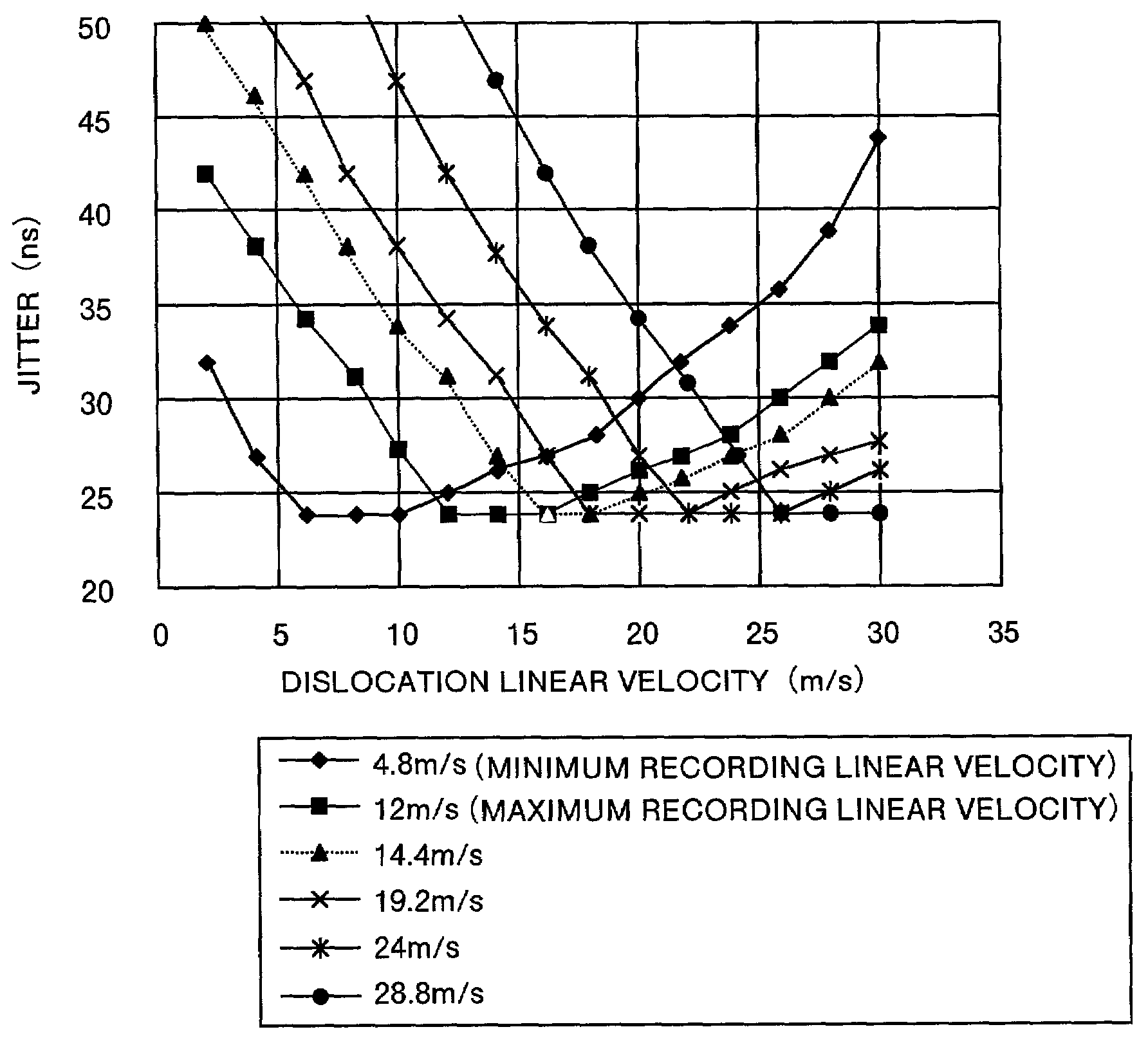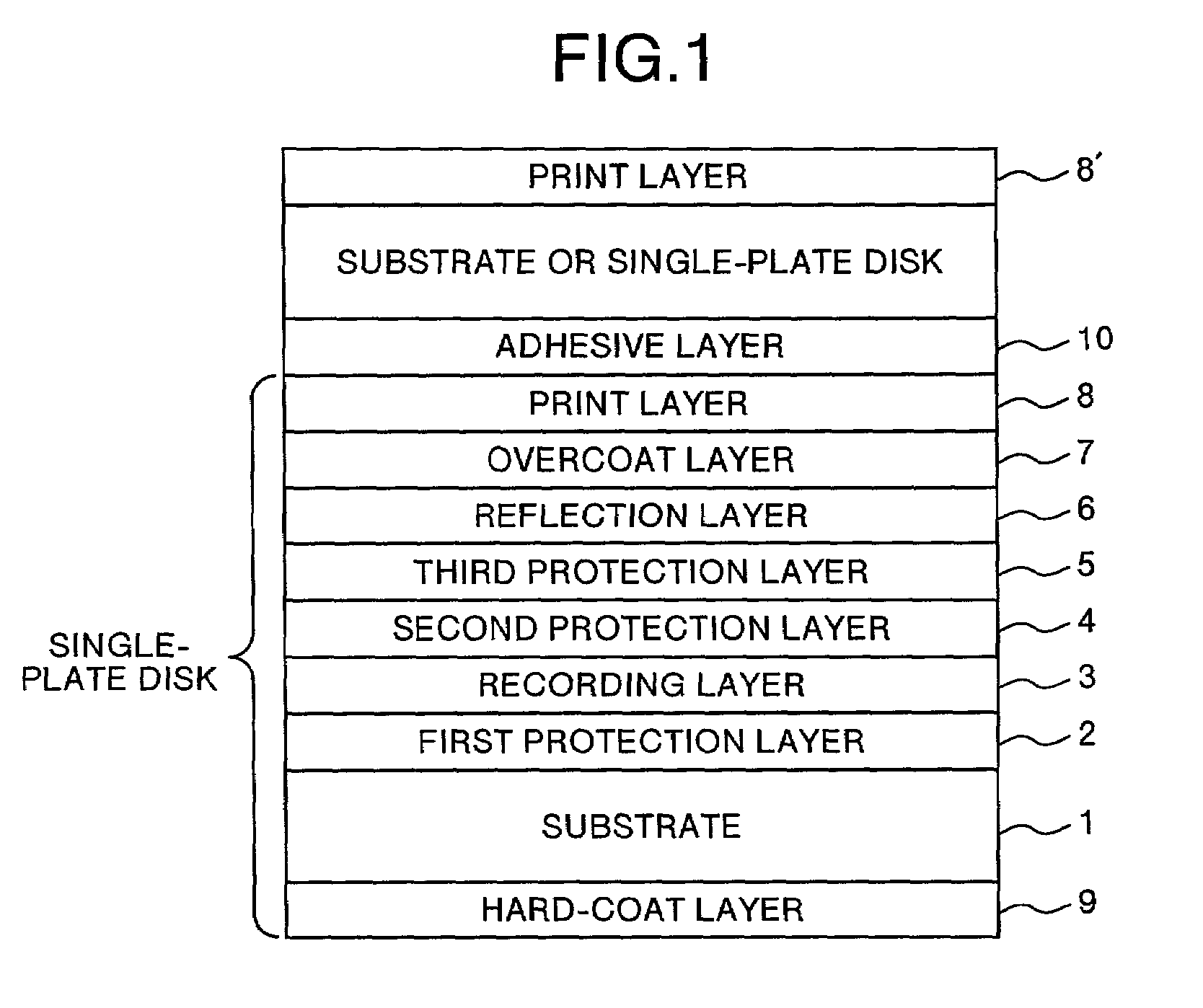Optical information recording medium, method of manufacturing the optical information recording medium, and method of and apparatus for recording/reproducing optical information
a technology of optical information and recording medium, which is applied in the field of optical information recording medium, method of manufacturing method of recording/reproducing optical information, etc., can solve the problems of increasing the demand for phase change optical information recording medium, unable to achieve a higher recording velocity, and difficult for optical information recording apparatus to perform matching at high-velocity recording
- Summary
- Abstract
- Description
- Claims
- Application Information
AI Technical Summary
Benefits of technology
Problems solved by technology
Method used
Image
Examples
example 1
[0151]A polycarbonate substrate 1 having a guide groove with a width of 0.55 μm and depth of 30 nm was prepared by injection molding. On this substrate 1, the first protection layer 2, recording layer 3, second protection layer 4, and the reflection layer 6 were laminated in this order using the sputtering method. The substrate 1 was put into the sputtering unit by keeping the substrate at 55° C. Information that the maximum recording linear velocity is ten times (i.e. 12 m / s) the speed of the CD was recorded onto the substrate 1.
[0152]The first protection layer 2 and the second protection layer 4 were made from ZnS.SiO2. The first protection layer 2 had a thickness of 90 nm and the second protection layer had a thickness of 30 nm. The recording layer 3 was made from Ge2In8Sb68Te22. The recording layer 3 was made 16 nm thick. The reflection layer 6 was made from AlTi (with Ti content of 0.5 weight percent). The reflection layer 6 had a thickness of 140 nm.
[0153]As a result, a lamina...
example 2
[0161]A polycarbonate substrate 1 having a guide groove with a width of 0.2 μm and depth of 27 nm was prepared by injection molding. On this substrate 1, the first protection layer 2, recording layer 3, second protection layer 4, third protection layer 5, and the reflection layer 6 were laminated in this order using the sputtering method . The substrate 1 was put into the sputtering unit by keeping the substrate at 55° C. Information that the maximum recording linear velocity is 8.44 m / s the speed of the CD was recorded onto the substrate 1.
[0162]The first protection layer 2 and the second protection layer 4 were made from ZnS.SiO2. The first protection layer 2 had a thickness of 75 nm and the second protection layer had a thickness of 10 nm. The third protection layer 5 was made from SiC. The third protection layer 5 had a thickness of 3 nm. The recording layer 3 was made from Ag0.5Ge1.5Ga8Sb68Te22. The recording layer 3 had a thickness of 14 nm. The reflection layer 6 was made fro...
examples 3 to 14
[0171]A polycarbonate substrate 1 was prepared by injection molding. On this substrate 1, the first protection layer 2, recording layer 3, second protection layer 4, third protection layer 5, and the reflection layer 6 were laminated in this order using the sputtering method.
[0172]The first protection layer 2 and the second protection layer 4 were made from ZnS.SiO2. The first protection layer 2 had a thickness of 80 nm and the second protection layer had a thickness of 10 nm. The third protection layer 5 was made from SiC. The third protection layer 5 had a thickness of 5 nm. The recording layer 3 was made from material having a composition shown in Table 1 to obtain Examples 3 to 14. The recording layer 3 had a thickness of 15 nm. The reflection layer 6 was made from Ag. The reflection layer 6 had a thickness of 140 nm.
[0173]As a result, a laminate having a layer structure as follows was formed. That is, the substrate 1 (composition: polycarbonate), first protection layer 2 (compo...
PUM
| Property | Measurement | Unit |
|---|---|---|
| linear velocity | aaaaa | aaaaa |
| linear velocity | aaaaa | aaaaa |
| depth | aaaaa | aaaaa |
Abstract
Description
Claims
Application Information
 Login to View More
Login to View More - R&D
- Intellectual Property
- Life Sciences
- Materials
- Tech Scout
- Unparalleled Data Quality
- Higher Quality Content
- 60% Fewer Hallucinations
Browse by: Latest US Patents, China's latest patents, Technical Efficacy Thesaurus, Application Domain, Technology Topic, Popular Technical Reports.
© 2025 PatSnap. All rights reserved.Legal|Privacy policy|Modern Slavery Act Transparency Statement|Sitemap|About US| Contact US: help@patsnap.com



